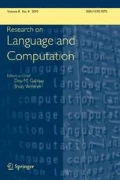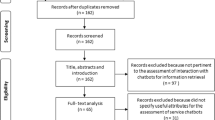Abstract
Pickering and Garrod (2004) argued that alignment is the basis of successful communication in dialogue. In other words, successful communication goes hand-in-hand with the development of similar representations in the interlocutors. But what exactly does this mean? In this paper, we attempt to define alignment, contrasting alignment of situation models with alignment of linguistic representations. We then speculate on how these notions are related and why they lead to conversational success
Similar content being viewed by others
References
Aijmer K. (1996). Conversational Routines in English: Convention and Creativity. Longman, London
Altmann G.T.M., Kamide Y. (1999). Incremental Interpretation at Verbs: Restricting the Domain of Subsequent Reference. Cognition 73:247–264
Branigan H.P., Pickering M.J., Cleland A.A. (2000). Syntactic Coordination in Dialogue. Cognition 75:B13–B25
Brennan S.E., Clark H.H. (1996) Conceptual Pacts and Lexical Choice in Conversation. Journal of Experimental Psychology: Learning, Memory, and Cognition 22:1482–1493
Brooks P., Tomasello M. (1999) Young Children Learn to Produce Passives with Nonce Verbs. Developmental Psychology 35:29–44
Chartrand T.L., Bargh J.A. (1999) The Chameleon Effect: The Perception-behavior Link and Social Interaction. Journal of Personality and Social Psychology 76:893–910
Clark E.V. (1993). The Lexicon in Acquisition. Cambridge University Press, Cambridge
Clark H.H. (1996). Using Language. Cambridge University Press, Cambridge
Clark H. H., Marshall C. R. (1981) Definite Reference and Mutual Knowledge. In Joshi A., Webber B., Sag I. A. (eds.), Elements of Discourse Understanding. Cambridge University Press
Clark H.H., Schaefer E.F. (1987). Concealing One’s Meaning from Overhearers. Journal of Memory and Language 26:209–225
Clark H.H., Wilkes-Gibbs D. (1986). Referring as a Collaborative Process. Cognition 22:1–39
Cleland A.A., Pickering M.J. (2003). The Use of Lexical and Syntactic Information in Language Production: Evidence from the Priming of Noun-phrase Structure. Journal of Memory and Language 49:214–230
Danet B. (1980). ‘Baby’ or ‘Fetus?’ Language and the Construction of Reality in a Manslaughter Trial. Semiotica 32:187–219
Ericsson K.A., Kintsch W. (1995). Long-term Working Memory. Psychological_ Review 102:211–245
Fadiga L., Craighero G., Buccino G., Rizzolatti G. (2002). Speech Listening Specifically Modulates the Excitability of Tongue Muscles: A TMS study. European Journal of Neuroscience 15:399–402
Fodor J.A., Bever T.G., Garrett M.F. (1974). The Psychology of Language. McGraw Hill, New York
Fowler C.A., Brown J., Sabadini L., Weihing J. (2003). Rapid Access to Speech Gestures in perception: Evidence from Choice and Simple Response Time Tasks. Journal of Memory and Language. 49:296–314
Garrod S., Anderson A. (1987). Saying What You Mean in Dialogue: A Study in Conceptual and Semantic Co-ordination. Cognition 27:181–218
Garrod S., Doherty G. (1994). Conversation, Coordination and Convention: An Empirical Investigation of how Groups Establish Linguistic Conventions. Cognition 53: 181–215
Garrod S., Pickering M.J. (2004). Why is Conversation So Easy?. Trends in Cognitive Sciences 8:8–11
Garrod S., Pickering M. J. (in press) Automaticity in Language Production in Monologue and Dialogue. In Wheeldon L., Meyer A. (eds.), Language and Executive Processes. Psychology Press
Goldinger S.A. (1998) Echoes of echoes? An Episodic Theory of Lexical Access. Psychological Review 105:251–279
Greenwald A.G., Banaji M.R. (1995) Implicit Social Cognition: Attitudes, Self Esteem, and Stereotypes. Psychological Review 102: 4–27
Gries S.T. (2005) Syntactic Priming: A Corpus-based Approach. Journal of Psycholinguistic Research 34:365–399
Hartsuiker R. J., Pickering M. J., Veltkamp E. (2004) Is Syntax Separate or Shared Between Languages? Crosslinguistic Syntactic Priming in Spanish/English Bilinguals. Psychological Science, 15, pp. 409–414
Haywood S. L., Pickering M. J., Branigan H. P. (2005) Do Speakers Avoid Ambiguities During Dialogue? Psychological Science, 16, pp. 362–366
Hommel B., Müsseler J., Aschersleben G., Prinz W. (2001). The Theory of Event Coding (TEC): A Framework for Perception and Action Planning. Behavioral and Brain Sciences 24:849–937
Horton W. S., and Keysar B. (1996) When Do Speakers Take into Account Common Ground? Cognition, 59, pp. 91–117
Horton W.S., Gerrig R.J. (2005) Conversational Common Ground and Memory Processes in Language Production. Discourse Processes 40:1–35
Hurley S., Chater N. (eds) (2005). Perspectives on Imitation, 2 Vols. MIT Press, Cambridge, MA
Isaacs E.A., Clark H.H. (1987). References in Conversations between Experts and Novices. Journal of Experimental Psychology: General 116:26–37
Jackendoff R. (1999). Parallel Constraint-based Generative Theories of Language. Trends in Cognitive Sciences 3:393–400
Jackendoff R. (2002). Foundations of Language. Oxford University Press, Oxford
Jefferson G. (1987). On Exposed and Embedded Corrections in Conversation. In: Button G., Lee J.R.E. (eds). Talk and Social Organisation. Multilingual Matters, Clevedon, pp. 86–100
Johnson-Laird P.N. (1983). Mental models: Toward a Cognitive Science of Language, Inference and Consciousness. Harvard University Press, Cambridge, MA
Kuiper K. (1996). Smooth Talkers: The Linguistic Performance of Auctioneers and Sportscasters. Erlbaum, Mahwah, NJ
Levelt W.J.M. (1989). Speaking: From Intention to Articulation. MIT Press, Cambridge, MA
Levelt W.J.M., Kelter S. (1982). Surface Form and Memory in Question Answering. Cognitive Psychology 14:78–106
Levinson S. C. (2003) Space in Language and Cognition: Explorations in Cognitive Diversity. Cambridge: Cambridge University Press
Lewis D.K. (1969). Convention: A Philosophical Study. Harvard University Press, Cambridge, MA
Meltzoff A., Moore M.K. (1977). Imitation of Facial and Manual Gestures by Human Neonates. Science 198:75–78
Nunberg G., Sag I.A., Wasow T. (1994). Idioms. Language 70:491–538
Pickering M.J., Garrod S. (2004). Toward a Mechanistic Psychology of Dialogue. Behavioral and Brain Sciences 27: 169–225
Pickering M.J., Garrod S. (2005) Establishing and Using Routines During Dialogue: Implications for Psychology and Linguistics. In: Cutler A. (eds). Twenty-First Century Psycholinguistics: Four Cornerstones. Erlbaum, Mahwah, NJ, pp. 85–101
Rizzolatti G., Arbib M.A. (1998). Language within Our Grasp. Trends in Neurosciences 21:188–194
Sanford A.J., Garrod S.C. (1981). Understanding Written language. Wiley, Chichester, UK
Schober M. F. (1993). Spatial Perspective Taking in Conversation. Cognition, 47, pp. 1–24
Schober M. F. (1995) Speakers, Addressees, and Frames of Reference: Whose Effort is Minimized in Conversations about Locations? Discourse Processes, 20, pp. 219–247
Schoonbaert S., Hartsuiker R. J., Pickering M. J. (in press) The Representation of Lexical and Syntactic Information in bilinguals: Evidence from Syntactic Priming. Journal of Memory and Language
Szmrecsanyi B. (2005) Creatures of Habit: A Corpus-Linguistic Analysis of Persistence in Spoken English. Corpus Linguistics and Linguistic Theory, 1, pp. 113–149
Tannen D. (1989). Talking voices: Repetition, Dialogue, and Imagery in Conversational Discourse. Cambridge University Press, Cambridge
Tabor W., Juliano C., Tanenhaus M.K. (1997). Parsing in a Dynamical System: An Attractor-based Account of the Interaction of Lexical and Structural Constraints in Sentence Processing. Language and Cognitive Processes 12:211–271
Watson M. E., Pickering, M. J., Branigan H. P. (2004) Alignment of Reference Frames in Dialogue. Proceedings of the 26th Cognitive Science Meeting Mahwah, NJ, Erlbaum
Zwaan R.A., Radvansky G.A. (1998) Situation Models in Language Comprehension and Memory. Psychological Bulletin 123:162–185
Author information
Authors and Affiliations
Corresponding author
About this article
Cite this article
Pickering, M.J., Garrod, S. Alignment as the Basis for Successful Communication. Research Language Computation 4, 203–228 (2006). https://doi.org/10.1007/s11168-006-9004-0
Published:
Issue Date:
DOI: https://doi.org/10.1007/s11168-006-9004-0




